Clinton 4-H Group Visits Campus, Experiences STEM at Illinois
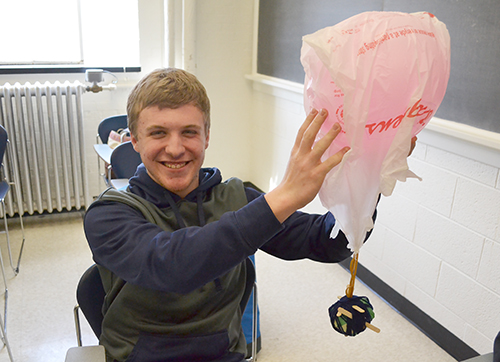
A student with the Clinton 4-H group shows off the egg-drop contrivance he and his teammate built during an Aerospace Engineering hands-on activity.
March 20, 2019
On March 4th, ten junior high and high school students, members of Clinton County’s 4-H Federation leadership group, traveled up from southern Illinois to spend the day on the Illinois campus. During their visit, they participated in STEM hands-on activities and briefly toured a number of campus buildings, including the IGB. While here, they were exposed to several STEM disciplines, dabbling a bit in Mechanical Engineering, Math, Aerospace Engineering, Molecular and Cellular Biology, and Entomology. Plus, they got to interact with a number of Illinois students to find out what being a student at Illinois might be like, as well as some possible career options.
The group’s first activity of the day was a visit to the Mechanical Engineering Lab to participate in several fun hands-on activities with Joe Muskin, Mechanical Science and Engineering’s Education Coordinator. Muskin sought to pique the young visitors’ interest in engineering by introducing them to several fun activities, but also appealed to their practical side by showing them a list of the highest paid starting salaries nationwide, most of which were in engineering.
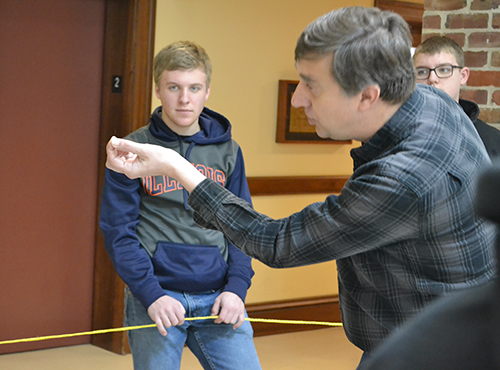
Joe Muskin illustrates the size of a "nanometer" compared to the diameter of a "human hair," which is the inside of the rope circle.
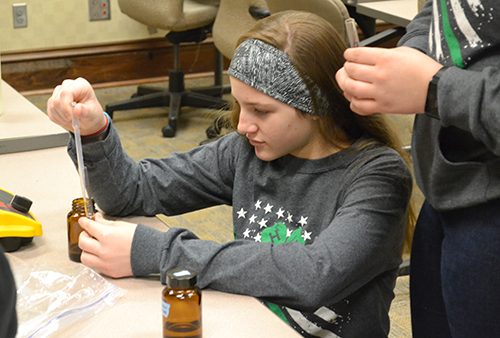
A student adds sodium citrate to hydrogen tetracholoroaurate to make gold nanoparticles.
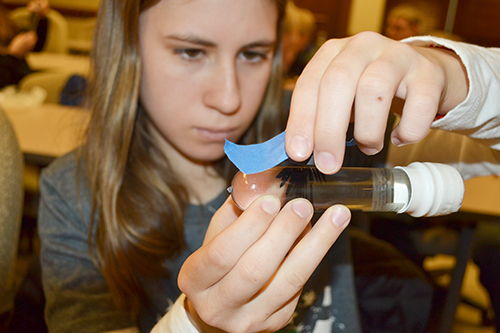
A student uses a magnet to move iron ferrite shavings around in a tube.
Before beginning his first activity, Muskin attempted to help the young people grasp nanotechnology and exactly how small a nanometer is (one-billionth of a meter). So he did a demonstration where students made a wide circle with a rope, which was to represent the diameter of a human hair. The tiny speck he held between his fingers represented the size of a nanometer in relation to the "hair."
The first hands-on activity Muskin led them in was extracting gold nanoparticles by adding sodium citrate to hydrogen tetracholoroaurate (HAuCl4), which they then heated in a boiling water bath until gold nanoparticles formed. The students were excited that they were allowed to take home the gold nanoparticles they’d made, and also to discover that they were actually worth 50¢ should they want to sell them on the internet!
ISS's final activity was a live video chat with an Illinois Aerospace senior and ISS member, Ryan Noe who is currently interning at NASA Johnson Spaceflight Center under the Pathways program. This opportunity brings in students for multiple rounds during the fall, spring, and summer sessions, and typically hires them for full time work right after graduation. Noe has one semester left and will be completing that this fall. During the chat, the younger students and leaders were able to ask him what his internship has been like and things he did while at Illinois to prepare for a career, possibly at NASA.
The next discipline students explored was Molecular and Cellular Biology (MCB), as Max Baymiller, an MCB PhD student and Outreach Co-coordinator of the MCBees (an MCB graduate student organization), introduced the students to the Tree of Life and Carl Woese’s proposal that the taxonomy used to classify all life include three domains: Archaea, Bacteria, and Eukarya as the highest level, rather than two kingdoms (animal and plant.) Following his discussion, students were given cards depicting various life forms and asked to classify them according to either Haeckel’s Tree of Life model proposed in 1879, or Woese’s 1990 scheme.
Following this introduction to Woese, students took a tour of Illinois’ Carl E Woese Institute of Genomic Biology (IGB), led by Courtney Cox Fenlon, the IGB Outreach Activities Manager. There they learned about research done at the IGB, and also got to see several labs, including a clean room, along with some art developed from IGB research.
In another activity, Muskin illustrated to the students some principles that might explain how a toy works that they probably used to play with when they were kids—a Magnadoodle or an Etch-A-Sketch. The students were given test tubes filled with water and iron ferrite shavings plus magnets, which they used to move the shavings around to create various designs.
In Muskin’s final activity, he introduced the students to NiTiNOL, a compound comprised of Nickel and Titanium made at the Naval Ordnance Laboratory, commonly known as memory metal. They received a small wire, which they were instructed to twist into a shape. Once they placed it in a beaker of hot water, however, they discovered that it reverted to its original shape. The students were also allowed to take the NiTiNOL home to play with.
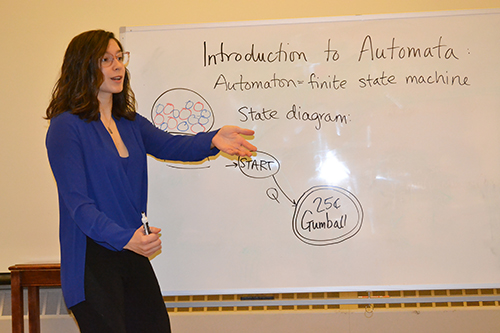
Alexi Block Gorman explains the Automata principle using a buying-a-gumball illustration.

A student works on her math worksheet.
Next, several members of the IGL (Illinois Geometry Lab) led the students in some fun activities about mathematics regarding Automata, or finite state machines. An automaton performs a function according to a range of predetermined programmed responses to different circumstances. To introduce the students to the mathematical idea, Alexi Block Gorman drew a state diagram of a gumball machine, to have them help figure out a number of scenarios where if the gumball costs 25¢, what are the various combinations of coins that one can use to purchase it (such as a dime, a dime, and a nickel). Her second example was using binary code (a string of 0s and 1s) to print something on a printer that will not print when a 0 is sent but will only print when it receives a 1. Students were then given some worksheets to complete related to those principles.
For lunch, the group got to experience the food court in the basement of the Illini Union. There, in addition to getting lunch, they got to feel what it might be like to be a college student as they were surrounded by a bunch of Illinois students who were eating, studying, or just hanging out.
Following lunch, the group took a brief detour to snap some obligatory photos at Alma Mater, then on to their next stop, a visit to Talbot Lab and Aerospace Engineering hosted by the Illinois Space Society (ISS), arranged by its Outreach Coordinator, Shivani Ganesh.
First the students had a brief tour of some of Talbot’s student work spaces, where they saw some of the many rockets ISS members had built for various competitions. Plus got to see one of the landmarks of the Talbot basement tour, the Rolls Royce rocket engine.
Following the tour, the group broke into teams to complete a fun aerospace-related hands-on activity, an Egg Drop competition. The idea was to use a number of materials, such as balloons, plastic grocery bags, cotton balls, etc., to build a contrivance similar to a parachute that would protect an egg during a fall…from a second story window in Talbot. Students came up with a variety of designs and learned some things about not just engineering but teamwork during the process. A few teams even successfully protected their eggs!
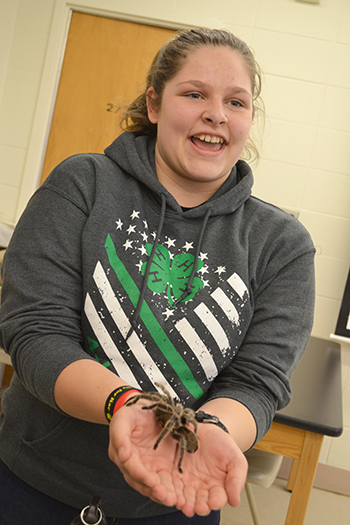
A student enjoys holding Cecelia the Tarantula.
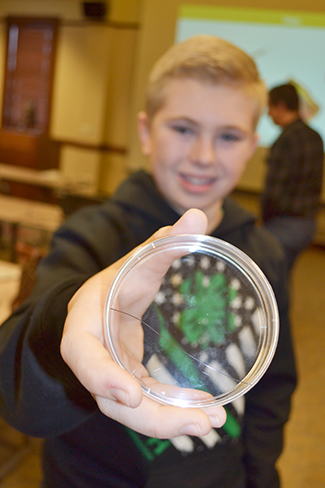
A student shows the piece of NiTiNOL he's taking home.
The group’s final activity of the day was a trip to Morrill Hall to interact with Ed Hsieh and Scott Clem, the two Outreach Coordinators of the Entomology Graduate Student Association (EGSA). In addition to viewing the EGSA’s insect collection and learning a lot about various insects, the more intrepid students (and leaders), were able to touch or hold different insects from Entomology’s Petting Zoo, including Cecelia, the Tarantula.
Cheryl Timmerman, 4-H coordinator for Clinton County, shares why she arranged for the group of students to do a campus visit. “Because one,” she says, “we want them all to come to the U of I. We want them to understand the opportunities that are here, and the best way to experience that is through the on-campus visits.” Timmerman adds that in the past, a few of the students have attended the 4-H Illinois Summer Academies, one-week camps in a number of different disciplines.
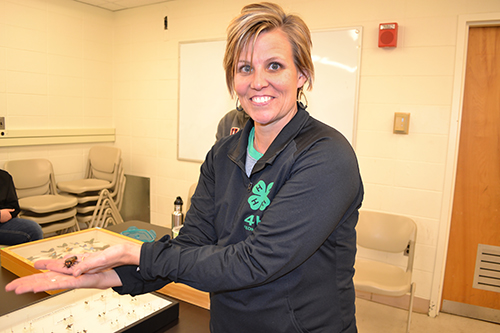
Cheryl Timmerman holds an insect from the petting zoo.
Timmerman indicates that she also wanted the students to be able to check out the engineering school as well as the College of ACES. She mentioned that when ACES’s Dean Kidwell had visited, some kids had expressed an interest in engineering and Kidwell had suggested that they could also get a similar degree through ACES. “She talked about the crossover and exploring all your options,” the 4-H leader recalls.
Timmerman’s take on the visit? “I think it's been great,” she reports. “STEM is obviously a focus everywhere, especially in the schools. The morning session and all the hands-on activities were great, making your own gold is pretty exciting, and then following it up with the math was an awesome experience for them.”
Timmerman believes her students were most engaged during Joe Muskin’s hands-on activities, the ISS students’ aerospace activities, and IGSA’s petting zoo.
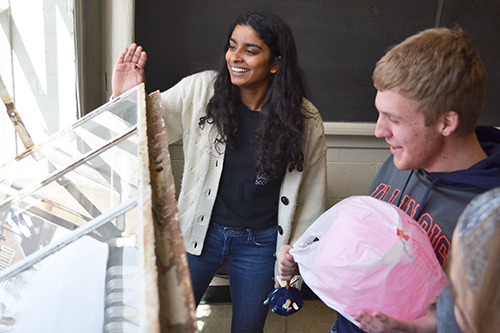
Shivani Ganesh and Colby Litteken prepare to drop his egg aparatus from a Talbot 2nd story window.
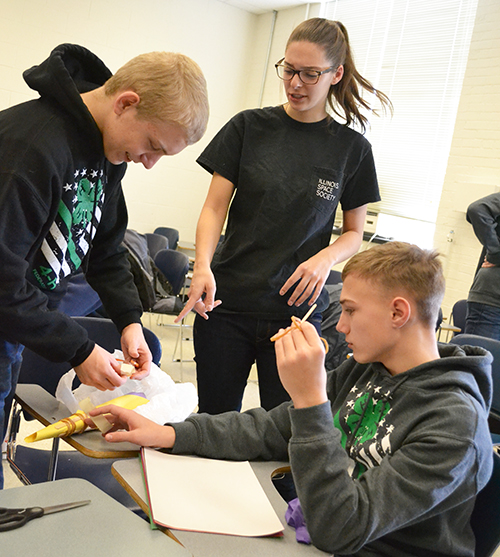
Christine Mehr (center) gives some advice to a couple of students building their egg-drop apparatus.
Why bring youth onto campus for visits? Shivani Ganesh, ISS's Outreach Coordinator, explains why she believes it's important: "Oftentimes, younger kids can get intimidated by the scope of engineering; I know I definitely have been! Bringing younger students to campus—specifically, the aerospace engineering community— epitomizes the fact that we're all just students pursuing what we're passionate about. Hence, we do our best to lead by example."
Christine Mehr, ISS's Assistant Director in charge of Professional Development, shares why she and her fellow ISS members were excited about doing activities with the southern Illinois group.
“We were all at that age where we didn't know what we wanted to do. So it's really exciting being able to show people that this is what you can do from engineering and help talk them through what it's really like, not only going to college but working in that field.”
She adds that the younger students weren’t the only ones to benefit, but that she and her fellow Aerospace students had also found the outreach to be rewarding. “Seeing their excitement reinvigorates your own passion, because sometimes you forget what it's really like to be passionate when you're so busy with your studies.”
One of the 4-H youth, Colby Litteken, a junior at Mater Dei Catholic High School in Breese, Illinois, shares why he wanted to come on the campus visit.
“I've been to U of I multiple times, and every time I've been here, I've fallen in love with this campus more and more. I've wanted to be an engineer since as far as I could remember, and I know they've got really good programs for that.” Littekin says he’s narrowed the field he intends to go into down to two, indicating that he’ll probably choose between mechanical and electrical engineering.
Story and photographs by Elizabeth Innes, Communications Specialist, I-STEM Education Initiative.
For more stories about 4-H, see:
- 4H STEM Specialist Keith Jacobs Shares His Passion for Technology With Illinois Youth
- 4-H Robotics: Working to Make a STEM Career Down the Line Automatic
- 4-H Exposes Youth to STEM Via Informal Education
More: 4-H, 6-8 Outreach, 8-12 Outreach, I-STEM Initiatives, 2019
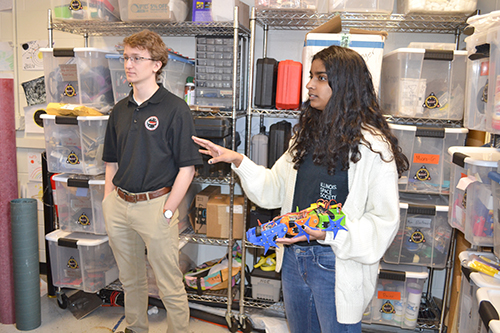
Above: Connor Latham, the ISS Technical Director and ISS Outreach Coordinator Shivani Ganesh show the students some equipment they've designed for rocket competitions.
Below: Two students remove the egg holder from their apparatus to discover that their egg had cracked when it hit the ground.
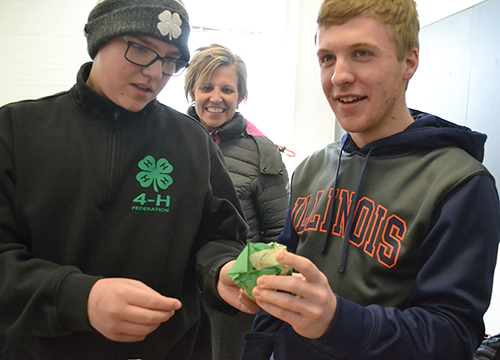

The group has a video chat with Ryan Noe, an Aerospace senior who's interning at NASA.
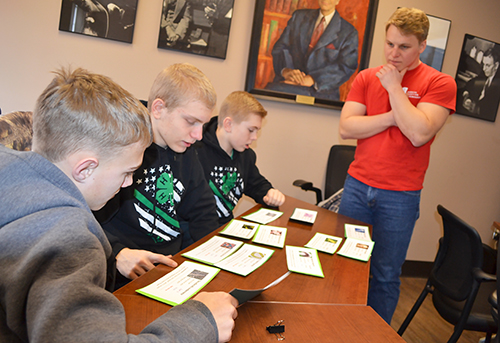
Max Baymiller, right, leads the students in a hands-on activity about Carl Woese's changes to taxonomy.
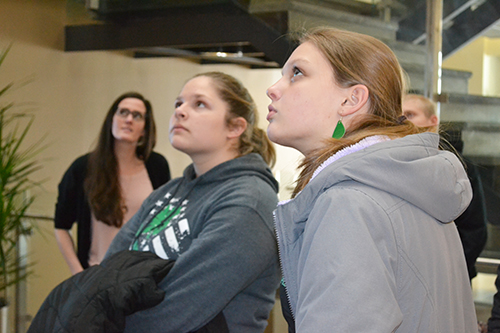
Courtney Fenion (left) and two students look at an art exhibit featuring reprints of research done in IGB.
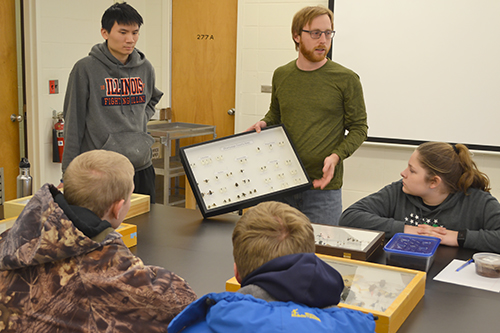
EGSA Outreach Coordinators Ed Hsieh and Scott Clem chat with the group about insects.
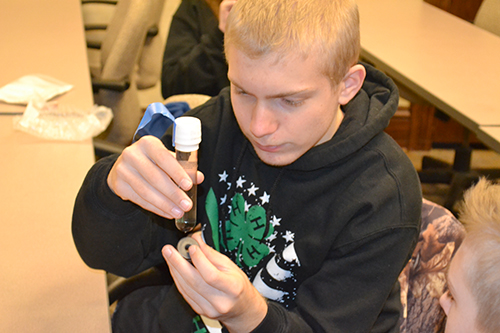
A student uses a magnet to make the iron ferite shavings in the tube move around.
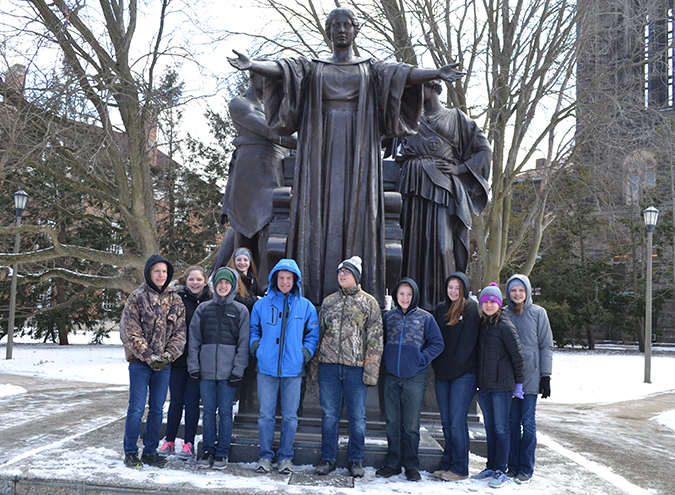
The Clinton 4-H group stops by Alma Mater for a photo.
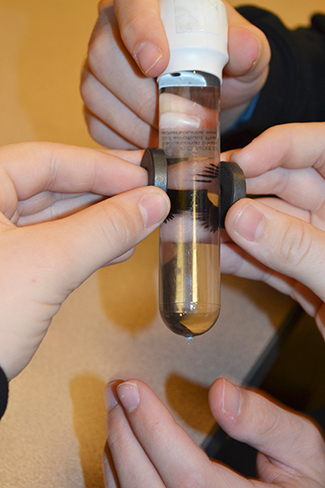
A student uses magnets to play with the iron ferrite shavings in the test tube.
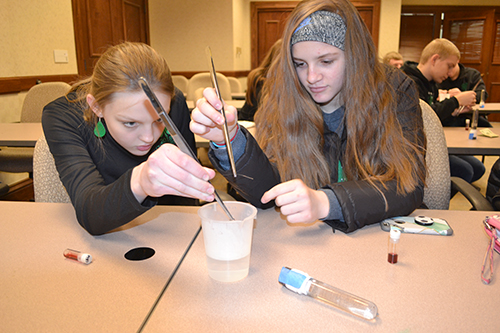
Two students immerse their NiTiNOL wires into hot water to watch them revert back to their original shapes.
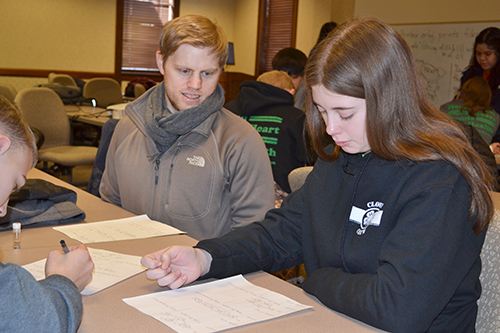
The director of the IGL, Math Associatet Professor Philipp Hieronymi, works with one of the students on the activity.













.jpg)
















